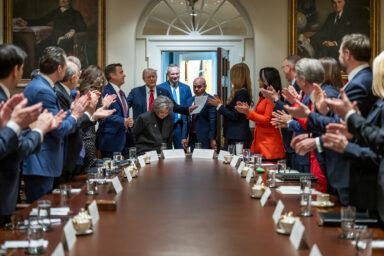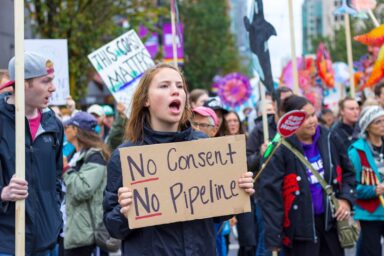New research shows how policies blocking cleaner energy sources, often inspired by persistent disinformation, harm the communities that adopt them.
|
Listen To This Story
|
Communities across the United States may soon find themselves facing a grim scenario. By adopting local ordinances that obstruct the development of new renewable energy resources within their borders, they have put themselves at risk of missing out on the next big technology-driven economic revolution: the clean energy transition.
As you read this, rapidly advancing renewable energy technology is transforming how we power the US economy in the 21st century, bringing with it new economic opportunities and social and environmental benefits. Yet the communities that have enacted or are considering anti-renewable energy ordinances may be left watching as the better jobs, cheaper electricity, and cleaner environment that come with this transition pass them by.
Many of these communities already face high unemployment and poverty rates, among other economic and social challenges, making the consequences of their legislation even more tragic.
The press and energy policy researchers have focused on these policies’ potential impact on achieving our nation’s broader decarbonization goals, but to date they’ve overlooked these broader consequences of anti-renewable energy ordinances.
It’s crucial that we closely watch how the benefits and costs of the clean energy transition are distributed, because previous technology-driven economic revolutions — such as those brought about by steam engines, electrification, and digital computers — have tended to reinforce preexisting socioeconomic inequities. The clean energy transition offers a critical opportunity not just to break this pattern, but to reverse it.
Can we imagine the clean energy transition unfolding in a way that reduces inequality?
In our recently published report, my co-author and I explored these issues by creating a new tool called the Risk of Missing Out Index, which scores each county in the continental United States based on the extent of harm its residents are likely to face because of local restrictions on renewable energy. The ROMO Index takes into account county-level data on employment and income, the amount of money that households spend on energy costs (their “energy burden”), and the presence of anti-renewable energy ordinances and other indicators of local opposition to renewable energy.
We also released an interactive map that allows users to see what, if any, clean energy restrictions exist in their communities and the impacts those restrictions might be having for them and their neighbors.
Our analysis reveals that anti-renewable energy ordinances are causing significant economic and social harms to communities across the United States, including some of the poorest and most economically distressed in the nation. One-quarter of all counties in the continental United States have restrictions in place targeting the development of wind, solar, or battery storage. Nearly a third of these communities are already experiencing substantially higher unemployment, lower per capita income, and other socioeconomic risks relative to comparable areas. And more than a third contain households facing high levels of “energy burden.”
To be clear, the point of this research is not to malign all local policies affecting renewable energy development. Plenty of room exists for sensible policies aimed at ensuring this development takes place at the pace needed to meet the challenge of the climate crisis without sacrificing the public interest. Many of the ordinances covered in our report, though, had the effect and intent of thwarting most renewable energy projects in a given community.
One County’s Story
Iroquois County in eastern Illinois illustrates the potential harms of these local restrictions. The county has a relatively high ROMO index due to its large low-income population, high unemployment rate, and low educational attainment level compared to the rest of the United States. Economic conditions there are at risk of getting even worse. Agriculture, the county’s dominant industry, has been left increasingly vulnerable to the effects of climate change. As a result, agricultural output has decreased significantly in recent years, putting the livelihoods of farmers in jeopardy.
Renewable energy development would seem to offer Iroquois County residents a badly needed economic lifeline, providing a pathway for diversifying local income sources and fortifying the community’s tax base. Thanks to its unique geography, the county ranks high for wind energy potential. Unfortunately its county government has adopted ordinances that significantly limit the development of both solar- and wind-power generation.
The good news for Iroquois County is that the Illinois state Legislature has recently taken action to prevent the harms of these kinds of local ordinances. In January 2023 it enacted legislation that established statewide zoning standards for renewable energy development, preempting those restrictions imposed by Iroquois County’s government (although the Iroquois County restrictions still remain on the books). Time will tell whether this measure provides renewable energy developers with the legal certainty they need to commence utility-scale projects in Iroquois County.
Optimism vs. Misinformation
Significantly, our research also uncovered other reasons for optimism. The Inflation Reduction Act (IRA) offers enhanced tax credits for renewable energy development in places deemed to be “energy communities” due to their weak economic performance and heavy dependence on fossil fuel extraction and use as a source of employment. Our analysis confirmed that relatively few energy communities (fewer than 1 in 5 overall) had adopted restrictive policies on renewable energy development. These results suggest that the IRA’s enhanced tax program has a lot of potential to help diversify and strengthen their economies.
Still, these findings raise an important question of their own: Why would so many communities adopt policies that go against their own citizens’ welfare?
Our research indicates that in some cases these ordinances may reflect good faith misunderstandings about the pros and cons of hosting renewable energy infrastructure.
In many cases, though, they’re the result of misinformation efforts designed to thwart renewable energy development. For example, our report identifies several campaigns carried out with the material support of the fossil fuel industry or organizations opposed to renewable energy on ideological grounds.
Whatever the explanation, it appears these restrictions are rarely the result of a well-functioning local democratic process — one capable of addressing mistakes or misinformation. Accordingly, our report offers recommendations for strengthening these processes so authentic community choice is better aligned with a just clean energy transition. They include better outreach strategies to rural communities by lawmakers and project developers, a greater commitment to using Community Benefits Agreements, and better planning for land stewardship in conjunction with renewable energy infrastructure development.
The clean energy transition offers the United States a valuable opportunity to build a fairer, stronger, and more inclusive economy. The path for achieving this goal must begin with replacing misguided local opposition with meaningful and durable local support.
This story by James Goodwin was originally published by The Revelator and is part of Covering Climate Now, a global journalism collaboration strengthening coverage of the climate story.
The opinions expressed above are those of the author and do not necessarily reflect those of WhoWhatWhy, The Revelator, the Center for Biological Diversity, or their employees.





